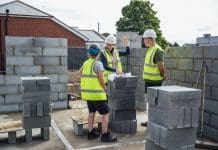A report from the Directory for Social Change takes a comprehensive look at how gender equality is imbalanced in the UK construction industry
Using company CSR policies and annual reports, the study was able to determine the gender equality statistics for 399 corporate boards. An analysis of the data shows that the overall percentage of women on boards was around 22%.
Although small, this number is actually higher than, it was in 2013, where similar reports found that only 13% of board members were women. However, of the remaining 78% of companies, 16% still confess to having purely male board members – excluding women entirely.
Gender inequality in construction
Much like the tech, science and other STEM industries, the construction industry is still lacking in gender equality and is dominated by men. In 2007, 12.1% of workers in construction was represented by female workers, whereas reports in 2016 showed that statistic only increased slightly to 12.8%.
In fact, a more recent study in 2018 by Wise found that the number of female employees in construction numbered just 11%, meaning the industry could actually be taking a step backwards.
Even in 2019 as a training provider, 3B Training hasn’t seen a huge percentage of women walk through the door for training courses when compared to men. Of nearly 10,000 delegates we have booked on courses so far, only 15% of those are women.
Overlooking female talent
It’s not just progression where women feel like they’re missing out, either. 8 in 10 women surveyed have felt left out of social events and conversations by their coworkers. This feeling of exclusion risks creating a toxic culture of bias throughout the industry.
Women leaders in construction
Due to the lower number of female workers in construction in general, it’s unsurprising to find that the industry is lacking in women at an executive level or higher. Nearly half of workers went so far as to say that they had never worked with a female manager.
Raising awareness
When it comes to women in construction being overlooked, unconscious bias and ignorance play a huge part in the issue.
There are only six construction companies in the UK that have an equal number of male to female directors or are female-led. One of those companies, Renishaw plc, has a board of 70% women and regularly runs engagement programmes with schools, universities and the government to help raise awareness of gender imbalance and overcome stereotypes.
Multinational human resource consulting firm Randstad has reached out to organisations to find out how they are currently supporting their female staff to help remove gender bias in the workplace:
Addressing the pay gap
A recent survey conducted by RICS, however, has found that the industry has acted and is making strides to address the issue. Whereas the construction industry had a gender pay gap of 36% in 2018 (one of the worst industries for pay disparity), it has since narrowed to 20.43%.
Although this is a positive result for the industry, more steps are needed before the pay gap is a thing of the past. Nearly half of construction companies not monitoring their gender pay gaps, so it’s difficult to accurately determine how well the industry is dealing with the issue.
By properly analysing and understanding exactly how men and women are paid, as well as being transparent about their pay policies, construction companies can work towards total equality of pay for their workers.
Changing perception and reducing stigma
Keepmoat conducted a survey on 1,000 adults between the ages of 16-25, looking at the differences in perception of the construction industry. The survey showed that 21% of men interviewed would consider a career in construction, but only 13% of women would do the same.
The prevailing narrative about construction is that it is physically demanding, creating a stigma for employment in construction. Roles in health and safety, construction management, procurement, surveying, estimating and site inspection are all potential routes that are available, yet people may not be aware of them.
Only 22% of construction companies work in schools to help to answer questions about the industry and encourage people to consider it as a potential career path.
Strategy for change
-
Create more opportunities for women
74% of women in Randstad’s survey were not part of any ‘women in construction’ initiatives that will help them progress to senior positions. This highlights the need for more programmes to help encourage women to get involved, as well as greater advertising that current programmes are available.
-
Provide education early
As we can see from Keepmoat’s survey, education is a real issue in the industry. 29% of female respondents feel like they’d be limited to on-site work and 56% were surprised to find out that a significant number of women in construction are hired at an executive level or higher.
With so many stereotypes around the construction industry, it’s important to educate people early about the potential career opportunities that are available. 64% of respondents claimed they would like construction companies to work closely with schools, colleges and universities. Without the right knowledge, many women will continue to believe that the construction is limited to working on a building site.
Addressing the problems with gender balance in construction may appear like a huge undertaking, but by companies adopting some of the methods we’ve discussed, they are chipping away slowly at the bigger picture – helping to create a pathway to gender equality.














